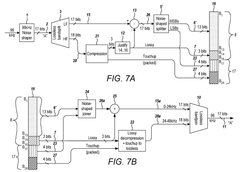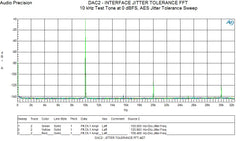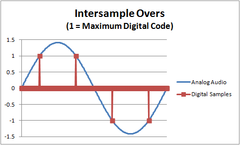Buy one component and save 10% on up to 2 cables. Buy 2 components and get 4 free cables. Free shipping on USA orders over $700.
Buy one component and save 10% on up to 2 cables. Buy 2 components and get 4 free cables. Free shipping on USA orders over $700.
Audio Application Notes
Rules of Thumb for Music and Audio
by John Siau April 01, 2019
As an engineer I like to use "rules of thumb" to make quick estimates that help to explain the physical world around me.
These rules of thumb are easy-to-remember approximations that eliminate the need for complicated and needlessly precise calculations.
If you feel discombobulated by the complexities of high school physics, there is hope! I encourage you to step back and take a fresh approach.
If you learn a few simple rules of thumb, you can unravel mysteries of the physical world, amaze your friends, and yourself.
In this paper I will present 15 simple rules that I find useful when working with music and audio.
- John Siau
Audio Myths - The Ultimate "Myth Buster" Video - Monty Montgomery, Xiph.Org
by John Siau March 14, 2017
Digital Show & Tell, Monty Montgomery, Xiph.org
Monty Montgomery takes us into the lab and uses a series of simple demonstrations to bust some very common myths about digital audio. Test your knowledge of digital audio. This video is fun to watch and easy to understand! Monty takes some difficult concepts and demonstrates them in a clear and simple manner.
Have doubts about Nyquist? Have a fear of stairsteps? Are you worried about ringing? Ever wonder what digital audio does to the timing of transients? This video is for you!
Myth - "Digital audio has stairsteps."
Myth - "Increased bit depths reduce the stairsteps."
Myth - "Analog tape has more resolution than digital audio."
Myth - "Dither masks quantization noise."
Myth - "Signals lower than one LSB cannot be reproduced."
Myth - "Digital filters make square waves and impulses ring."
Myth - "Digital systems cannot resolve timing between samples."
Intersample Overs in CD Recordings
by John Siau February 10, 2017
Intersample Overs are a Common Occurrence in CD Recordings
We have frequently used Steely Dan's Gaslighting Abbie from Two Against Nature in our listening tests. This is a spectacular CD recording with lots of dynamics and a low noise floor. Nevertheless, in a little over 5 minutes, this track has 559 intersample overs on the left track and 570 on the right track for a total of 1129. This means that there are about 3.7 intersample overs per second. The highest intersample over measures +0.8 dBFS. The track itself is not clipped, the 44.1 kHz sampling has simply captured peaks that exceed 0 dBFS. The following image shows the track with the intersample overs highlighted in red:
This track can be played cleanly by the Benchmark DAC2 and DAC3 converters. These converters accurately render the intersample peaks that were captured in the recording process. In contrast, conventional converters will clip each of the peaks highlighted in red. In this track the peaks coincide with hits to the snare drum. Converters that clip these peaks add a false brightness to the snare drum and alter its sound.
- John Siau
Inside the DAC2 - Part 2 - Digital Processing
by John Siau June 24, 2016
The Benchmark DAC2 is an audio digital-to-analog converter. This application note explains the proprietary digital processing inside Benchmark's DAC2 D/A converter. In part 1 of this series we made the case that 90% of the components in an audio converter are analog, and that about 90% of the "magic" happens in the analog processing. Nevertheless the 10% that is digital still makes an audible contribution to the sound of an audio D/A converter. This is especially true when the digital processing is complemented by a very pure and clean analog section. With a highly transparent analog section, some of the subtleties of the digital processing can become apparent.
Take a tour of the digital processing chain in the DAC2.
- John Siau
The PLL in your D/A Can Taint A/B Listening Tests!
by John Siau June 03, 2016
A/B and A/B/X listening tests are important methods of comparing two audio sources or two audio components. In the studio an engineer may want to switch an effect or EQ setting on and off to decide if it contributes positively to a mix. Hi-Fi enthusiasts may wish to compare audio components, signal sources and interconnects. The DAC1 and DAC2 converters have input selector switches that allow fast and easy switching between signal sources. Before attempting to conduct these tests, it is important to understand how these converters and their switches work. A/B tests using the DAC1 input selector can be very misleading. In contrast, A/B testing using the input selector on the DAC2 will produce reliable results. This application note provides guidance for conducting reliable A/B or A/B/X listening tests with your D/A converter.
- John Siau
Is MQA DOA?
by John Siau May 05, 2016
The truth is that we may add MQA to the list of audio formats that have come and gone. This list includes HDCD, DVDA, and DSD. All three of these claimed to deliver some sort of sonic improvement, but all three have suffered from a lack of content. HDCD and the DVDA are dead while DSD may be on its death bed. All three were supported by hardware but have died due to a lack of recordings in these formats. It should be noted that the DVDA did bring us high resolution audio formats and these have survived while the DVDA itself has died. Two dead, one dying ... is MQA next?

To those of us who are interested in the best possible musical playback, the small details are important. The promise of "improved sound" always catches our attention ...
- John Siau
Audio Myth -"DSD Provides a Direct Stream from A/D to D/A"
by John Siau August 27, 2015
This myth goes something like this:
"DSD provides a simple and direct digital path between the A/D and D/A."
"DSD is simpler than PCM."
"DSD is not PCM."
While DSD can provide spectacular audio performance, all of the statements above are false.
There are many wonderful DSD recordings, but the quality is not due to any virtues of the DSD format.
Direct Stream Digital (DSD) seems like a simple and attractive system, but it absolutely fails to deliver a "direct" path between the A/D and the D/A.
- John Siau
Benchmark DAC2 vs. DAC1 - Is There an Audible Difference?
by John Siau August 06, 2015
Benchmark introduced the DAC1 in 2002 and it quickly became the best-selling 2-channel professional D/A converter. To this day, the DAC1 is a standard fixture in many recording studios, and it is also a central component in many high-end hi-fi systems. In August of 2015, Enjoy the Music.com selected the DAC1 as one of the 20 most significant digital audio products from the past 20 years.
It is easy to show that the DAC2 measures better than the DAC1 in almost every way. From a marketing perspective it would be tempting to claim that all of these measured differences make audible improvements, but this just isn't the case.
One reviewer, Gary Galo, recently had the opportunity to hear a DAC1 and DAC2 side-by-side. He noted some audible differences and we agree with his conclusions. We have had a great deal of experience listening to these converters side-by-side in our own listening room and we are familiar with some subtle differences.
This paper examines the subtle audible differences between the DAC1 and the DAC2. It also includes measurements that may help to explain these differences.
- John Siau
Creating a High-Resolution 5.1 Music Server
by John Siau April 21, 2015
Blu-ray disks often contain high-resolution audio formats. Dolby TrueHD and DTS-HD are two Blu-ray audio encoding formats that support lossless high-resolution audio. These systems support up to 8 channels of 24-bit, 96kHz audio, or up to 6 channels of 24-bit 192 kHz audio.
Blu-ray disks may seem like an ideal solution for the distribution of high-resolution audio, but there are problems. It is not easy to gain access to the high-resolution audio stored on these disks.
Our solution was to set up a PC-based music (and video) server. We used a Blu-ray equipped PC running Windows 7 and the JRiver MediaCenter software.
This application note provides a guide for setting up a music server that can play the lossless high-resolution audio tracks found on DVD and Blu-ray disks.
- John Siau
High-Resolution Audio - Sample Rate
by John Siau March 19, 2015
Sample Rate

Digital audio systems take instantaneous snapshots or "samples" of an analog audio signal and then store each of these samples as numeric values. The digital samples can be stored and transmitted without any loss of quality, but these samples must be used to reconstruct an analog signal before we can listen to the audio. The sample rate places very specific limitations ...
- John Siau
High-Resolution Audio - Bit Depth
by John Siau February 24, 2015
Bit Depth

We now have 16-bit CDs and 24-bit high-resolution recordings available to us. What are the advantages of a 24-bit word length? Are 24-bit recordings better? How many bits do we really need?
Bit depth (also known as word length) indicates how many bits are used to represent each sample in a digital sampling system. Each sample is a snapshot of a signal or voltage at an instant in time. The CD uses 16 bits to represent the voltage of an audio waveform at each instant in time. Other digital audio systems use different bit depths ranging from 1 to 64 bits. It is important to understand the relationship between bit depth and audio quality. The bit depth sets ...
- John Siau
Jitter in A/D Converters
by John Siau October 03, 2014

All A/D converters have two forms of jitter: Conversion clock jitter, and interface jitter. These two forms of jitter are very different and have very different consequences. Conversion clock jitter...
- John Siau
What High-Resolution Audio is NOT
by John Siau August 27, 2014
"Low-Resolution Hardware Cannot Deliver High-Resolution Audio"
The music industry is struggling to define High-Resolution Audio or "HRA". In doing so, most have focused on the delivery formats - analog vs. digital, 24-bits vs. 16-bits, 1X vs. 2X and 4X sample rates, PCM vs. DSD, uncompressed vs. compressed.
But, High-Resolution Audio is much more than the delivery format ...
"High-Resolution Audio Requires High-Resolution Performance at all Stages of the Recording and Playback Chain"
- John Siau
Audio Myth - "24-bit Audio Has More Resolution Than 16-bit Audio"
by John Siau August 14, 2014
This myth goes something like this:
"Analog audio has infinite amplitude resolution."
"Digital audio is limited to a finite number of steps."
"24-bit audio has more resolution than 16-bit audio."
While it is true that digital systems quantize the amplitude of the audio signal to the nearest step in the digital encoding system, this does not necessarily mean that digital systems cannot have infinite resolution. Contrary to popular belief, digital systems can provide infinite amplitude resolution if they are properly dithered.
- John Siau
The Mac Mini as a High-Resolution Audio Server
by Benchmark Media Systems June 27, 2014
A "Mini" Server for High-Resolution Audio
Mastering and Recording Engineer, Mark Waldrep (A.K.A. Dr. AIX) recently published an excellent application note titled "My First Server". This is a step-by-step guide for setting up a High-Resolution Audio (HRA) server. He chose a Mac Mini, a Benchmark DAC2 HGC, and the highly-acclaimed Amarra playback software to bring studio-quality playback to his own living room.
With his simple guide, you can join Mark, and enjoy mastering-quality High-Resolution Audio in your room.
The CE Mark - What Does it Mean, and Why Should I Care?
by John Siau June 17, 2014
Why is the CE Mark Important?
Many electronic products have a "CE" mark affixed to the product. This mark is mandatory in European markets, but is not required on products sold elsewhere. Few people understand what this mark means and why it is important. It is often a good idea to look for this mark when purchasing a product. It is also important to understand the differences between professional and consumer audio products (as defined in the CE standards).
- John Siau
Why "Audio Goes to 11"
by John Siau April 17, 2014
Intersample Overs - Part 2

In my last post, "Audio that Goes to 11", I made the bold assertion that most of our audio recordings contain peaks that exceed the limits of our digital hardware. In this post I will show how this happens, and explain why this is a problem in PCM audio systems.
Do we throw out PCM and move to DSD?
Is there another solution?
- John Siau
Audio That Goes to 11
by John Siau April 10, 2014
Intersample Overs - Part 1

But, it's not just Spinal Tap recordings that go to 11, every recording you own may also go to 11! How is this possible? If 10 is the clip point of digital audio, how can there possibly be an 11? And, if we use Nigel's logic; if 10 is good, why isn't 11 better?
- John Siau
What is High-Resolution Audio? - Part 2
by John Siau April 03, 2014
Is there Life Beyond 20 kHz?
High-Resolution Audio systems offer the promise of an extended high-frequency range. High-Resolution digital systems now operate at 2 to 4 times the sample rate of the standard CD. This means that these systems have the capability of extending the playback frequency range well above the 22 kHz limit of the standard CD. Does this added high-frequency range improve our listening experience? How high is high enough? Do we really need anything over 20 kHz?
If we want to accurately reproduce 20 kHz audio, the frequency response of each component must extend well beyond 20 kHz.
- John Siau
What is High-Resolution Audio? - Part 1
by John Siau March 27, 2014
Eliminate the Noise!
There is a raging debate over the definition of "High-Resolution Audio". The focus of this debate has been misdirected by a lot of marketing hype. High-Resolution Audio will only truly arrive when the sum total of all defects in the audio chain become inaudible. We are not there yet, but we are getting close. The final chapter will not be higher sample rates and more bits. The final chapter will be achieving the necessary improvements to critical components in the signal chain.
If your playback system can't resolve anything better than CD quality, then "High-Resolution Audio" will remain an illusion.
- John Siau






















